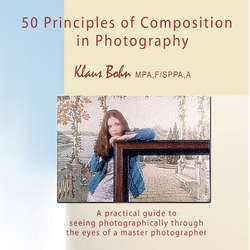Читать книгу 50 Principles of Composition in Photography: A Practical Guide to Seeing Photographically Through the Eyes of A Master Photographer - Klaus Bohn - Страница 7
На сайте Литреса книга снята с продажи.
ОглавлениеIntroduction
According to Webster’s definition, “composition” is a “putting together of a whole, the make-up of anything and/or a mixture of substance.”
There are no rules to composition, only guides and extremely flexible principles that may help us to see more sensitively instead of in a hit or miss manner. The more aware we are manner. The more aware we are of effective composition, the more satisfaction we may derive from photography. Learning to give form and balance by putting together the elements harmoniously can help us see a subject in the strongest way.
Learning the ABC’s of photography begins with the technical education of our equipment and light. Composition is an elementary step. Most beginners are in search of a formula or recipe to which they can rigidly adhere. This, of course, is an illusion! Any recipe for good composition is similar to that of a chef who begins to work instinctively -- a dash of this and a pinch of that. We must remember that composition is the selection and arrangement of an object within the picture format by using space most effectively.
Photography, being communicative, means we must learn to compose our meaning using the least number of elements to tell the story in the briefest way. Showing as much as we need, but no more! The basic decision is thus, “What to include, and what to leave out.” Brevity is the economy of means.
Photography brings a visual language that is universal in understanding. We must then understand its vocabulary which consists of shapes, textures, patterns, lines, colours, shade of light to dark and sharp to blurry images. Just as we must learn to arrange words in a coherent order in order to make sense when we write or speak, so too must we put visual elements together in an organized manner if our photographs are to convey their meaning clearly and vividly.
Composition means arrangement: the orderly putting together of parts to make a unified whole; composition through a personal, intuitive act. However, there are basic principles that govern the way visual elements behave and interact when you combine them inside the four borders of a photograph. Once we have sharpened our vision and grasped these basic ideas of principles, then we will have the potential for making our photographs more exciting and effective than ever before.
A photographer lives through their eyes. The basic way of photographic “seeing” is an essential step in being able to communicate photographically. In mastering composition, one must cultivate the ability to see shapes, lines, forms, masses, etc., and not to just recognize objects. Even more importantly than that, we must be able to visualize in our mind’s eye just how the objects will look when they are reproduced on a flat piece of paper. This is brought out only through practice and experience. Through practice, this procedure should become second nature; an unconscious, automatic habit. By knowing the format of a photograph, we can then learn to previsualize the photograph in a positive and effective manner. Remember, seeing involves the mind as well as the eyes.
A painter has total freedom when it comes to putting what they want into their painting. A photographer is restricted to recording what is in front of their lens. The space fenced off by the four edges of the camera’s ground glass is the photographic area. The photographer has an advantage over the painter, though, in being able to freeze a split second of time -- peak action. By using space effectively and not just filling it, the arranging of shapes and tones within the area can help convey the photograph’s meaning and help reinforce it’s emotional effect. But what should be included or excluded? How big should you make things? Where should you place an object in relation to another object, and in relation to the edges of the photograph? These principles will be discussed in full.
By what criteria or standard do we judge a photograph as good or bad? The eye and mind expect certain things in order to enjoy certain things. If the photograph fulfills these expectations then it is basically a success. One of the simple tricks of composition is to keep the eye from running out of the picture before it has been fully satisfied. When watching for this, there are three essential qualifications:
1. Good technical quality (focus, light, exposure, etc.)
2. Interest or impact (storytelling)
3. Good composition (keeps the eye in the photograph)
As mentioned, there are no ironclad rules that we must follow for composition, just principles or guides for ease of expression ie. something that can be understood universally with a historical continuum in influencing the photograph being composed.
The fifty principles of composition presented in this book will greatly benefit both amateur and professional photographers in developing their own photographic art.
